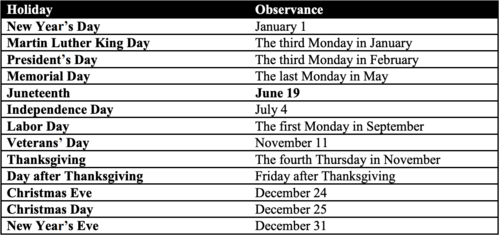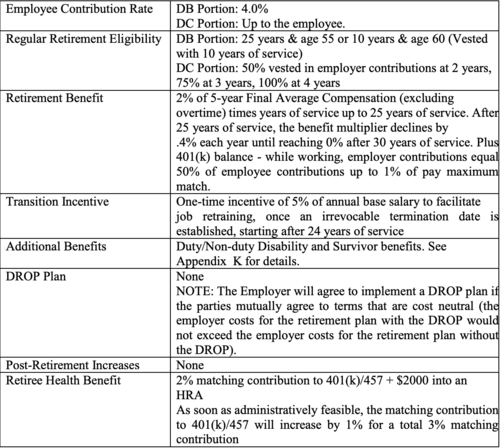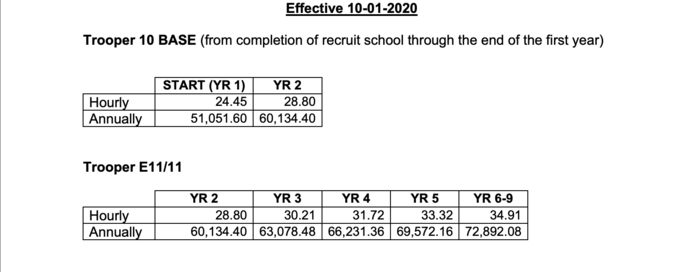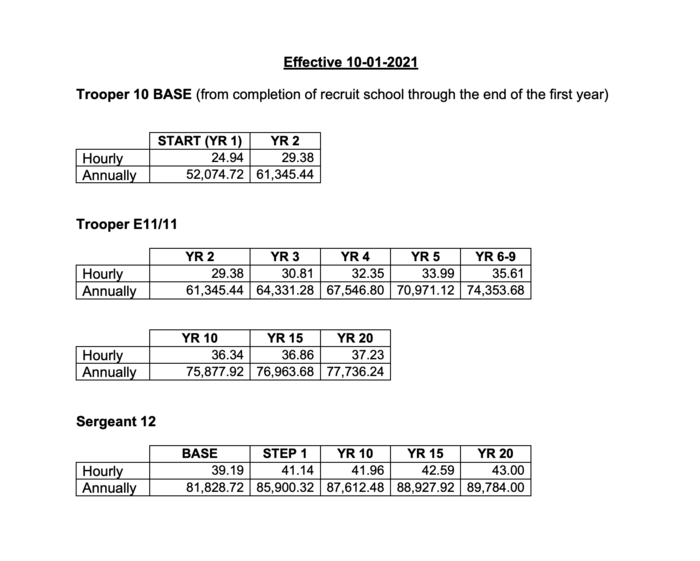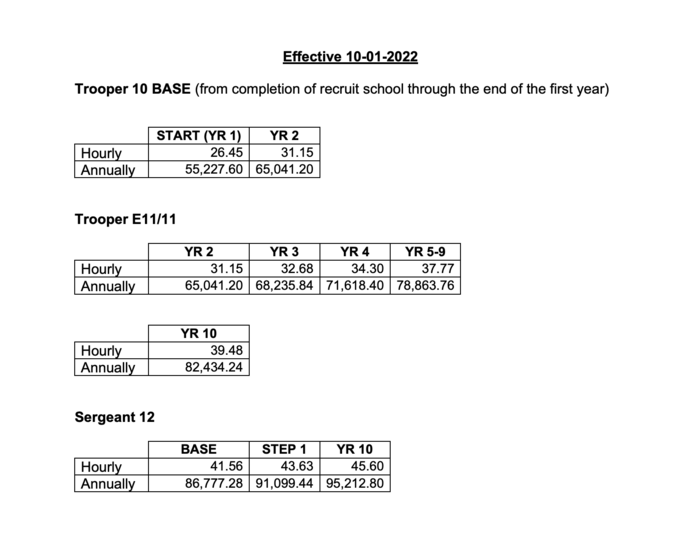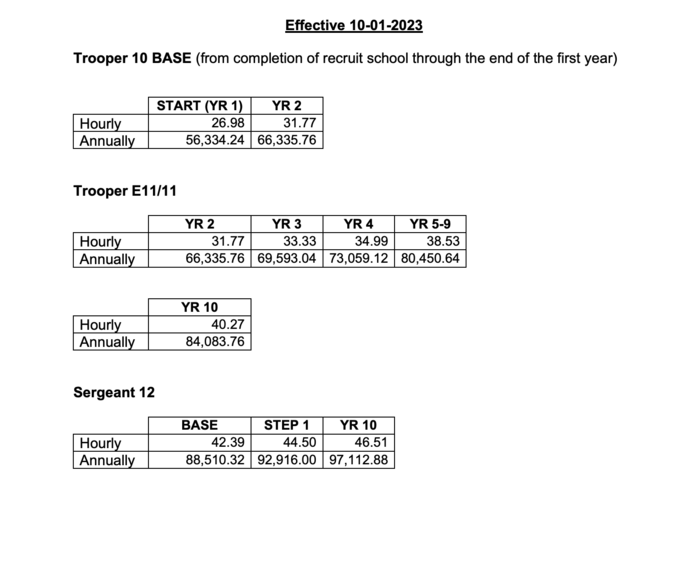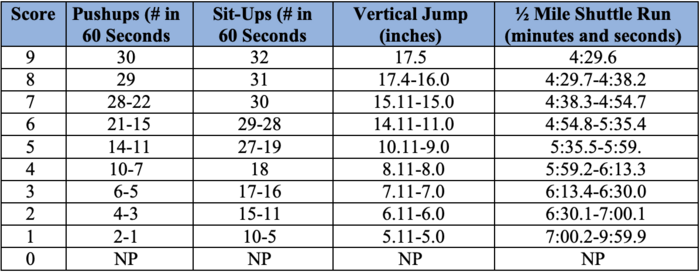| “
|
Part A. Pension Plan
Section 1. 1986 PA 182
The State will maintain the State Police Pension Plan as provided in the State Police Retirement
Act of 1986 (P.A. 182 of 1986), MCL 38.1601 et seq., as it exists on the effective date of this
Agreement, except as provided in Sections 10 and 11 of this Part and except as provided in Part
B and Part C.
Section 2. Revision of 1986 PA 182
In the event that 1986 PA 182 is amended during the term of this Agreement, and such
amendment addresses a subject which is a mandatory subject of bargaining between the parties,
this Agreement does not require that such amendment(s) be applied to employees or positions in
the bargaining unit.
Section 3. Insurances
Bargaining unit members who have retired on or after the effective date of this Agreement under
1986 PA 182 (except current Section 30, MCL 38.1630) or their beneficiary and dependents, shall
be entitled to enroll in Group Dental and/or Vision Care Plan authorized for active employees by
the Michigan Civil Service Commission and the Department of Management and Budget. 90%
of the applicable premiums payable by the retirant (or the retirant's beneficiary and enrolled
dependents) for such coverage shall be paid by the State.
Bargaining unit members who have retired on or after the effective date of this Agreement under
Public Act 182 of 1986 (except current Section 30, MCL 38.1630), or their beneficiaries and
dependents, shall continue to be entitled to enroll in the Group Health Care Plan authorized for
active employees by the Michigan Civil Service Commission and the Department of Management
and Budget. 95% of the applicable premiums payable by the retirant (or the retirant's beneficiary
and enrolled dependents) for such coverage shall be paid by the State.
Claims for services provided prior to enrollment shall not be payable under this Agreement.
As soon as administratively feasible, bargaining unit members who have retired and are enrolled
in Medicare Part A and Part B, may enroll, at their option, in Medicare Advantage.
Section 4. Pension Benefit
Consistent with 1986 PA 182, any pension which becomes payable on account of the attainment
of 25 years of service credit, duty-incurred disability, or duty-incurred death of a bargaining unit
member on or after October 1, 1986 shall be equal to 60% of the employee’s final average
compensation; any pension which becomes payable on account of the nonduty-incurred death or
disability of a bargaining unit member on or after October 1, 1986 shall be calculated on the basis
of the applicable years of service credit multiplied by 2.4.
Section 5. Deferred Retirement
A deferred pension shall continue to be calculated on the basis of years of service credit (not to
exceed 25 years) times 2, as provided in Public Act 182 of 1986.
Section 6. Final Average Compensation
Whenever the term "average annual salary" is applied to members of this bargaining unit, in
accordance with past practice and 1986 PA 182, this term shall include the following:
- a. Regular salary paid for the last two years of service including, but not limited to, that salary which is deferred pursuant to the state deferred compensation program;
- b. Overtime, shift differential, and shift differential overtime paid for the last two years of service;
- c. Workers' Compensation benefits paid for the last two years of service;
- d. The following gross pay adjustments affecting the last two years of service:
- 1. Administrative Leave
- 2. Annual Leave
- 3. Call Back
- 4. Compensatory Time
- 5. Civil Rights Adjustment
- 6. Emergency Response Compensation
- 7. Fair Labor Standards Act Adjustment
- 8. Hazard Pay
- 9. Jury Duty
- 10. Military
- 11. On-Call
- 12. Overtime
- 13. Personal Sick Leave (except for payment for accumulated but unused sick leave at separation)
- 14. Reallocation (including retroactive classification actions)
- 15. Retroactive General Increase
- 16. Shift Differential
- 17. Shift Differential Overtime
- 18. Step Increase
- 19. Time and Attendance Adjustment
- 20. Working out of Class (under provisions of the Collective Bargaining Contract);
- e. Up to a maximum of 240 hours of accumulated annual leave, paid at the time of retirement separation;
- f. Deferred hours (Plans B of FY 1980-81 and FY 1981-82) that are paid at the time of retirement separation;
- g. Longevity pay (two full years);
- h. Bomb squad paid for the last two years of service;
- i. On-call pay paid for the last two years of service.
Section 7. Adjusting Service Time
For purposes of computing average annual salary pursuant to these same statutory provisions, the
term "last two years of service for which the member was paid" shall be calculated based on the
payments made to the employee, for the compensation elements specified in Section 6 above
during the 24 calendar month period immediately preceding retirement. If the employee did not
receive full compensation in any of the 24 months immediately preceding retirement, an amount
of time equal to the lost time shall be included, so that Final Average Compensation is based on
24 complete months of earnings. Adjustments, if necessary, shall be made using the time
immediately prior to the final 24 months of service.
Section 8. Procedure for Handling of Disability and Death Claims
The parties adopt and incorporate the following procedures for handling applications for
disability and death allowances submitted by or on behalf of bargaining unit members under the
State Police Retirement Act of 1986 (the Act), MCL 38.1601 et seq, and this Collective
Bargaining Agreement. The parties agree that these procedures are intended to be applied in a
manner that will allow the expeditious processing of claims that are clear and undisputed, while
providing an efficient process for gathering information and acting on applications where there
are factual or legal issues that must be resolved by the Board.
- A. Disability. A bargaining unit member may request a duty- or non-duty disability retirement allowance by filing an application with the Office of Retirement Service (ORS), which acts on behalf of the State Police Retirement Board (the Board). The application shall be on a form developed by the ORS and shall identify all medical or psychological conditions in support of the application.
- 1. The Director of the Department of State Police may submit an application on behalf of a bargaining unit member, if the Director believes that a question regarding the existence or extent of a disability exists and that the bargaining unit member may be entitled to a duty- or non-duty retirement allowance. In this event, the ORS shall provide the affected bargaining unit member with a copy of the application and the bargaining unit member will be considered an applicant for purposes of these procedures with the same rights and responsibilities as a bargaining unit member who voluntarily submits an application for a disability retirement allowance. Any requests for accommodation by an applicant under the Americans with Disabilities Act (ADA) or the Persons with Disabilities Act shall be made to the Department of State Police, and not to the ORS under these procedures.
- 2. Upon receipt of an application for a disability retirement allowance, the ORS shall appoint a physician, acting as an Independent Medical Advisor (IMA). The IMA will review the applicant's medical records and other relevant information to determine if the applicant meets the criteria for a State Police disability retirement. The IMA may request additional information or testing to assist in making this determination. If requested by the IMA, the ORS will schedule a medical examination of the applicant and the applicant shall cooperate by attending the examination and/or reporting for the requested test(s).
- 3. If the IMA determines that the disability and its extent meet the criteria for a State Police disability retirement, the Board authorizes the ORS to do either of the following:
- i. Waive the application review by a Medical Review Panel and approve the non-duty disability application; or
- ii. Waive the application review by the Medical Review Panel and present the duty- incurred disability application to the Board to determine whether the disability was duty-incurred.
- 4. If the IMA determines that the disability and its extent are not sufficiently documented and indicates that a bona fide disagreement as to the existence or extent of the disability may exist, the ORS shall arrange a Medical Review Panel.
- i. The Medical Review Panel shall consist of the IMA, a physician designated by the Director of the Department of Community Health, and a physician selected by the applicant. If the applicant fails to provide the name of his or her selected physician within 30 days after the notice of the Medical Review Panel, the application will proceed based upon the information that is available to the remainder of the Panel.
- ii. Either the applicant or the Director of the Department of State Police may submit additional information to the Medical Review Panel that is relevant to the existence, extent, or relationship to duty of the disability. The information shall be provided to the ORS within 30 days of the notice of the Medical Review Panel. The ORS shall be responsible for providing the information to each member of the Medical Review Panel.
- iii. Any member of the Medical Review Panel may waive an in-person examination of the applicant if he or she believes that the medical evidence, test results, and any other information that has been submitted is sufficient to formulate an opinion regarding the existence of a disability or its extent.
- iv. After the Panel has reviewed all medical evidence, test results, and any other information that has been submitted, and after the applicant has been examined (if deemed appropriate), the Medical Review Panel shall determine, based solely on the medical evidence submitted by the parties and any examination conducted, whether or not a disability exists and whether or not its extent meets the criteria for a State Police duty- or non-duty disability retirement.
- v. Each member of the Medical Review Panel shall complete a medical advisor statement concerning the disability and its extent.
- vi. If a bargaining unit member seeks a duty-incurred disability retirement allowance and the relationship to duty depends upon the interpretation of medical facts, the Medical Review Panel may render an advisory opinion on this issue.
- vii. After a Medical Review Panel has considered an application for a disability retirement, ORS shall promptly forward to the applicant, the applicant's representative, and the Director of the Department of State Police, the following information:
- a. A copy of the findings of the Medical Review Panel on disability and its extent; and
- b. A copy of the Medical Review Panel's advisory opinion(s), if any, on the issue of the disability's relation to duty.
- viii. In the absence of a timely-filed appeal by the applicant under Subsection c. of this Section, the findings of the Medical Review Panel as to the existence of a disability shall be binding.
- 5. When a question of relationship to duty arises in a disability case and it cannot be resolved upon the basis of the applicant's medical condition and history, the ORS may, on its own, or at the request of the Director of the Department of State Police, conduct an investigation. This does not preclude the Department of State Police from initiating its own investigation and submitting the results to the ORS, with a copy to the applicant.
- 6. If the ORS denies a disability retirement allowance of any kind, the ORS shall notify the applicant in writing of its action. The notification shall inform the applicant of the right to request an evidentiary hearing as set forth in Subsection c.
- 7. If the ORS denies a duty disability retirement allowance but determines that the criteria for a non-duty disability allowance have been met, the ORS shall notify the applicant in writing of its action. The notification will inform the applicant of the right to request an evidentiary hearing as set forth in Subsection c.
- 8. If the ORS denies a duty disability retirement allowance but determines that the criteria for a non- duty disability allowance have been met, the applicant may make a written request to the ORS that it process the non-duty disability retirement and pay that allowance during the pendency of a final decision by the Board on the issue of duty relatedness. Upon receipt of such a request, the ORS shall process the claim for non-duty disability benefits without prejudice to the applicant's right to seek duty-incurred disability benefits, retroactive to the date of retirement.
- b. Death. If a bargaining unit member dies, a surviving spouse or beneficiary may file an application for a death allowance. The Director of the Department of State Police shall promptly notify the ORS of the bargaining unit member's death so that a determination can be made regarding the spouse's or dependent(s)' eligibility for a duty-incurred or non-duty death allowance.
- 1. If ORS determines that there is no dispute that the bargaining unit member’s death meets the criteria for a non-duty death benefit and that the bargaining unit member had the necessary time in service, the Board authorizes the ORS to promptly approve the application and process benefits in accordance with MCL 38.1627.
- 2. If ORS determines that there is no dispute that the bargaining unit member’s death meets the criteria for a duty-related death allowance, the ORS shall promptly schedule a special meeting of the Board to consider whether the bargaining unit member's death meets the criteria for a duty-related death allowance.
- 3. If ORS denies a non-duty or duty-incurred death allowance, it shall notify the applicant in writing of its action. The notification shall inform the applicant of the right to request an evidentiary hearing as set forth in Subsection c.
- 4. If the Board denies an application for a duty-related death allowance without first giving the applicant notice of the right to request a hearing, the ORS will notify the spouse or eligible beneficiaries of the denial. The notification shall inform the applicant of the right to request an evidentiary hearing as set forth in Subsection c.
- 5. If the Board denies the application for a duty-incurred death allowance under paragraph 4. above but determines that a non-duty death allowance is payable, it shall direct the ORS to process a non-duty death allowance without prejudice to the right of the spouse or beneficiary to exercise the right to a hearing under Subsection c. below.
- c. Request for Hearing. If, without first giving the applicant notice of the right to request a hearing, the ORS or the Board denies an application for a duty or non-duty disability retirement allowance or death allowance, the ORS shall notify the applicant of the denial and of his or her right to request a hearing on this issue.
- 1. The notice shall inform the applicant that the request for a hearing must be filed in writing with the ORS within 60 days after the date the notice was mailed and that the request
should contain all of the following:
- a. A fair and accurate statement of the facts as the applicant understands them;
- b. The reason(s) supporting the applicant's claim; and
- c. The reasons why the determination regarding the absence of a disability or the determination to deny duty- or non-duty death or disability benefits should be reversed.
- 2. Upon receipt of a timely request, the ORS shall arrange for an administrative hearing without undue delay.
- 3. The hearing, proposal for decision, and final decision and order, shall be conducted and administered pursuant to the contested case procedures of the Administrative Procedures Act, 1969 PA 306, as amended, being MCL 24.271 – 24.287. Medical reports and records shall be admitted into evidence by the presiding officer in lieu of requiring attendance at a hearing by medical personnel.
- 4. In the event the applicant or the employer offers into evidence at the hearing the deposition(s) of a treating physician and/or an independent medical examination physician hired by the employer whose reports or materials appear within the administrative record for the hearing, the presiding officer shall admit the deposition(s) into evidence and may determine the appropriate evidentiary value to be given to the deposition(s). Nothing herein precludes the applicant or the employer from producing the deponent as a witness at the hearing.
- 5. The applicant and the ORS shall be furnished with a copy of the proposal for decision issued by the presiding officer and any exhibits or other items of public record that will be submitted to the Board to be used in making its final decision.
- 6. The Board shall review the findings and proposal for decision submitted by the presiding officer. Neither the findings of the Medical Review Panel nor the proposal for decision shall be binding on the presiding officer or the Board. The Board shall issue a final decision in the matter, which shall be based upon competent, material, and substantial evidence in the whole record.
- 7. The final decision of the Board may be reviewed by a court as set forth in the Administrative Procedures Act, 1969 PA 306, as amended, being MCL 24.301 - 24.306.
- d. Except as modified by the current or a future Collective Bargaining Agreement, the rights of bargaining unit members and their retirement beneficiaries to a retirement allowance shall be in accordance with the provisions of the State Police Retirement Act of 1986 (1986 PA 182, as amended), MCL 38.1601, et seq., as it existed on October 1, 2005.
Section 9. Post Retirement Adjustment.
An employee (or beneficiary if applicable) shall be entitled to receive the annual post retirement
adjustment set forth below, if:
- a. The employee is eligible for a retirement allowance under 1986 PA 182 directly following separation from state service and has a retirement allowance effective date on or after October 1, 1989, or
- b. The employee defers retirement under MCL 38.1630 on or after October 1,1989.
Each retirement allowance shall be increased each October 1 beginning with the later of October
1, 1990 or the first October 1 which is at least 12 months after the retirement allowance effective
date. The amount of the annual adjustment shall be equal to two percent of the initial retirement
allowance not to exceed $500.
The annual adjustments are cumulative but are not compounded. Once the first adjustment is
received, the monthly benefit will increase by the same amount each October 1 thereafter.
Section 10. Survivor Pension Payments.
- a. Any individual hired after July 1, 2006 as a new bargaining unit employee may elect, prior to retirement, a survivor (spouse or child less than 18 years of age) retirement allowance option of 100%, 75%, or 50% at actuarially reduced monthly payments, including dutyincurred disability and non-duty disability retirement. An eligible survivor beneficiary shall be either a spouse, brother, sister, parent, child, including an adopted child, or grandchild of the person making the designation. If the retiring employee is married at the time of retirement, the spouse must sign off on any designation that does not name the spouse as 100% survivor beneficiary.
- b. A bargaining unit member or deferred bargaining unit member who elects one of the survivor options and whose retirement allowance beneficiary dies before the retirant shall have his or her retirement allowance increased to the full, straight life amount.
- c. A retirant, who is divorced after payment of his or her retirement allowance begins and whose former spouse is his or her retirement allowance beneficiary, may change his or her survivor option to the straight life option only if an order of the court states that the election of a survivor option under paragraph (a) of this section is to be considered void by the retirement system. A retirant who subsequently remarries may elect a survivor retirement allowance option for his or her spouse of 100%, 75%, or 50% of his or her actuarially reduced monthly payments, unless otherwise precluded by court order.
- d. A bargaining unit member who is not married at the time of retirement and did not elect a retirement allowance beneficiary who subsequently marries may elect a survivor retirement allowance option for his or her spouse of 100%, 75%, or 50% of his or her actuarially reduced monthly payments.
- e. A retirant whose spouse is the designated survivor beneficiary may change his or her retirement allowance beneficiary if the beneficiary predeceases the retirant and the retirant subsequently remarries and wishes to designate the new spouse as a retirement allowance beneficiary.
- f. For any of the allowable changes to a retirement allowance beneficiary after retirement, survivor retirement allowance payments shall be based upon the retirant's and his or her spouse's ages at the time of their marriage. The retirant must file a written request with the retirement system to name his or her current spouse as a retirement allowance beneficiary not earlier than 180 days and not later than 1 year after the marriage of the retirant and the current spouse. A spouse who is added as a retirement allowance beneficiary in this manner is not eligible for the payment of insurance premiums. If the retirant dies no later than 12 months after the effective date of the new survivor retirement allowance, the spouse’s survivor payments ,must terminate after the death of the retirant.
- g. If a retirant elects a survivor retirement allowance option after his or her retirement under paragraph c. or d. of this Section, the retirement allowance beneficiary shall only be designated as such for that portion of the retirement allowance not subject to an eligible domestic relations order assigning a previous spouse a reduced benefit under MCL 38.1704(b).
Section 11. Employee Contribution
- a. Effective October 1, 2012, Bargaining Unit employees covered by the State Police Defined Benefits Retirement Plan will contribute 1% of compensation to such plan.
- b. Effective October 1, 2013, Bargaining Unit employees covered by the State Police Defined Benefits Retirement Plan will contribute an additional 1% of compensation to such plan for a total contribution of 2% of compensation.
Part B. Deferred Retirement Plan Option
Section 1. Eligibility and Plan Overview
An employee who has 25 years or more of credited service under the State Police Retirement Act
of 1986, as amended, or former act 1935 PA 251, or both, may elect to participate in the deferred
retirement option plan (DROP) by executing the application provided by the Office of
Retirement Services. Once the application is accepted by the Office of Retirement Services, the
employee's participation in the DROP is irrevocable and he or she becomes a DROP participant.
The employee is solely responsible for any federal, state, or local tax due as a result of his or her
participation in the DROP.
Participation in the DROP does not guarantee continued employment. Except as otherwise
provided in this article, an employee who elects to participate in the DROP will remain an active
employee eligible to receive any applicable wage changes and benefits and will be subject to
policies and procedures of the Department of State Police in the same manner as if he or she had
not elected to participate in the DROP.
For each fiscal year that begins on or after October 1, 2004, the Director of State Police and the
Retirement Board may elect to discontinue accepting applications for the deferred retirement
option plan.
Section 2. Participation Period
An employee shall indicate on the application for the DROP the number of years that the
employee wants to participate in the DROP, up to a maximum of six years. As a condition for
participation, the employee agrees to retire at the conclusion of his or her participation in the
DROP.
Section 3. DROP Benefit and Account
A deferred retirement option plan account shall be created in the accounting records of the
retirement system for each DROP participant. Each deferred retirement option plan account shall
earn interest at the rate of 3% per annum, prorated for any fraction of a year. The DROP account
of a DROP participant shall be credited with the following percentage of his or her monthly
retirement allowance as calculated pursuant to MCL 38.1624 as if he or she had retired on the
day prior to becoming a DROP participant:
- a. 100% if the employee remains in the DROP for six years.
- b. 90% if the employee remains in the DROP for five years but less than six years.
- c. 80% if the employee remains in the DROP for four years but less than five years.
- d. 70% if the employee remains in the DROP for three years but less than four years.
- e. 60% if the employee remains in the DROP for two years but less than three years.
- f. 50% if the employee remains in the DROP for one year but less than two years.
- g. 30% if the employee remains in the DROP for less than one year.
A DROP participant shall not receive a monthly retirement allowance, as calculated pursuant to
the Retirement Act, until termination of his or her DROP participation and commencement of
retirement. A DROP participant shall not have any claim to any funds in his or her DROP account
until he or she retires at the termination of his or her DROP participation.
Section 4. Distribution of DROP Funds
Upon termination of the DROP participation and commencement of retirement, the former
DROP participant shall select one or more of the following options with regard to his or her
DROP account:
- a. A total lump sum distribution.
- b. A partial lump sum distribution.
- c. A lump sum direct rollover to another qualified plan if allowed by federal law and subject to the procedures of the retirement system.
- d. Maintain the funds in the account.
A former DROP participant shall remove all funds from his or her DROP account no later than
April 1 following the later of the calendar year in which the DROP participant attains 70 years,
six months of age or the calendar year in which the DROP participant is retired.
Section 5. Death or Disability
If a DROP participant or former DROP participant dies before removing all funds from his or her
DROP account, the former DROP participant's designated beneficiary shall receive any remaining
balances. If the former DROP participant has not named a beneficiary for his or her DROP
account, the amount in the DROP account shall be paid to the beneficiary of the former DROP
participant's retirement allowance. If the former DROP participant has not named a beneficiary
to his or her retirement allowance, the balance in the former DROP participant's account shall be
paid to the former DROP participant's estate.
If a DROP participant is found to be disabled under MCL 38.1629, his or her participation in the
DROP shall immediately cease and he or she shall be retired.
Section 6. IRC Compliance
The DROP shall be administered in compliance with Section 415 of the Internal Revenue Code,
26 USC 415, and regulations under that section that are applicable to a governmental deferred
retirement option plan. If there is a conflict between this section and another section of this article,
this section prevails.
If the department receives notification from the United States internal revenue service that this
article or any portion of this article will cause the retirement system to be disqualified for tax
purposes under the internal revenue code, 26 USC 1 through 1789, then the portion that will cause
the disqualification does not apply.
Section 7. Special Provisions
Notwithstanding any other contractual provision, the following special provisions apply to a
DROP participant:
- a. At the time of acceptance to the DROP, the DROP participant shall be paid for his or her accrued eligible sick leave, subject to Subsection g. A DROP participant shall not accrue any further sick leave. A DROP participant may use up to 240 hours of sick leave for which payment was not received. No payment will be made at retirement for any unused sick leave.
- b. At the time of acceptance to the DROP, the DROP participant shall be paid for his or her accrued annual leave up to 240 hours, subject to Subsection g. Any accrued annual leave in excess of 240 hours may be used by the DROP participant.
- c. Excluding participation in the banked leave time program, each DROP participant shall receive a total of 7.7 hours of annual leave for each 80 hours of paid service in a biweekly work period; however, the maximum number of annual leave hours that a DROP participant may accumulate, including annual leave hours remaining prior to DROP participation, is 200 hours. If a DROP participant is not paid for 80 hours in a biweekly work period, the participant shall be credited with a prorated amount of annual leave for that work period. A DROP participant on an alternative work schedule of more than 80 hours of paid service in a biweekly work period shall only receive 7.7 hours of annual leave in the biweekly work period. At retirement, the DROP participant will only be paid for a maximum of 76 hours of annual leave.
- d. Drop participants shall not be eligible for, and cannot receive, any longevity pay.
- e. As of the effective date of participation in the DROP, a participating employee is paid for all accrued compensatory time. As of the effective date of participation in the DROP, a participating employee and the employee's supervisor may agree to allow the employee to accrue up to 48 hours of compensatory time. A participating employee is paid for up to 48 hours of unused compensatory time at retirement.
- f. DROP participants shall pay group insurance plan premiums equal to the amount the employee would have paid if the employee had retired on the day before becoming a DROP participant.
- g. Payments due an employee upon approval to participate in the DROP, such as for accrued sick leave, annual leave, compensatory time, and similar items, may be paid at the sole discretion of the state, at the rate of 17% per year until the DROP participant retires, at which time any remaining balance shall be paid. This provision shall not affect how an employee's final average compensation is determined for purposes of calculating his or her retirement benefit pursuant to section 24 of the retirement act.
- h. Solely for purposes of voluntary transfer under the provisions of Article 13, a trooper shall be considered as having three years of time in service seniority, and sergeants shall be considered as having one year of time in rank seniority.
- i. DROP Participants shall be paid at the appropriate 15-year pay rate. In the event the Trooper and Sergeant pay ranges in Article 36 are modified effective April 3, 2022, DROP Participants shall be paid at the appropriate 10-year pay rate
Section 8. Additional Provision
In the event command officers of the department are offered terms in DROP benefits relating to
Section 3 and Section 7 g. above, that the Association considers favorable to them in the same
sections, the Association, upon notice and demand to the Office of the State Employer, will be
granted the same provision for all employees as are granted to the command officers for the
duration of the current agreement.
Part C. Defined Benefit/Defined Contribution Hybrid Plan for New Troopers
Section 1. Eligibility and Plan Overview
The Defined Benefit/Defined Contribution Hybrid Retirement Plan will cover all new
Bargaining Unit employees beginning with the 123rd Trooper Recruit School.[2]
|
”
|







